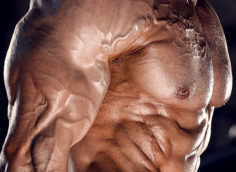There's no arguing that the push-up is a good exercise. That's one reason why you see so many home push-up challenges. But all that pressing volume needs to be balanced out.
The Chinese back plank is an entirely different strength challenge, and you can do it anywhere. Grab three chairs and see if you can hold for 30 seconds or more. Your back strength and posture will thank you for the attention.
- Have a timer ready.
- Grab some chairs or stools. You can also use your couch if it works. The height doesn't matter.
- Place the chairs that come in contact with your upper body approximately shoulder-width apart. The third chair (or couch) should be far enough away to put your feet on.
- Rest your elbows and feet on the three chairs, lift your hips up, and drive your elbows down. Start the timer once you're in position.
- Squeeze your hamstrings, glutes, and abs while pulling your elbows down to activate your mid-back.
- As soon as your hips or chest drop from the hold, stop the timer.
- If you held it for 0-10 seconds: Well done for trying, but your strength-to-bodyweight ratio definitely needs some improvement.
- If you held it for 10-30 seconds: Many fail to even hold for a few seconds, so well done. However, there's more work needed here.
- If you held it for 30-60 seconds: Good job, you've made the cut. Around 30 seconds is the target fitness level for both males and females. You've shown you can handle your own bodyweight, and your back and posterior chain strength is up to an acceptable standard.
- If you held it over one minute: No one likes a showoff.
Too Many Push-Ups
When working out from home, we often do too many push-ups. This happens when push-up challenges spread like wildfire. Do too many of those and you'll be creating a ton of imbalances.
Flip a push-up on its back and you've got yourself a back plank. These effectively target your traps and rhomboids, helping build strength in muscles that push-ups miss.
More Sitting at Home
It's easy to find yourself in a forward-slumped posture with poor spinal and pelvic alignment. You're probably even slumped a little right now.
Well, if you're frequently in poor alignment, it will be evident when you're lifting heavy weights too. Flip a Chinese back plank 90 degrees and you've got what should look like a good standing posture. Your glutes and core should be engaged, with your shoulders and neck in a far better position. Developing strength here will carryover to everything from walking to deadlifting.
Home Workouts Are Too "Anterior"
When you exercise at home your training inevitably becomes more anterior chain dominant. It's much easier to push, squat, and lunge than it is to deadlift and row. That means more chest and quads and less of everything else.
Back planks recruit your entire posterior chain, force optimal postural alignment, and efficiently recruit your calves, hamstrings, glutes and spinal erectors.
Back Planks Challenge You Isometrically
Isometrics have many uses when working with your own bodyweight or limited resistance, some of which include high levels of muscle activation and creating a blood occlusion-type of effect. Plus, planks are just downright difficult, and isometrics can help you maintain muscle and strength.
Back Planks Are Easy to Scale
When doing these as a challenge, use the setup described above. When using these as part of a workout routine, though, you'll want some way to scale them depending on your ability.
To take it up a level, throw some weight across your hips. For some efficient parenting, a small child would even work. You can also do these on one leg, although be prepared for some serious glute and hamstring cramping.
To make them easier, have your feet on the floor and hips in a bridged position.
Let us know how you did with the back plank challenge by sharing and tagging us on Facebook or Instagram. Your target is 30 seconds. Shoot this to a friend who likes a good challenge too!




